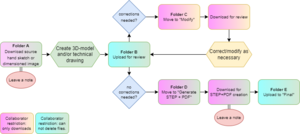Industrial Hemp Harvesting Machine (fiber): Unterschied zwischen den Versionen
K |
|||
| Zeile 43: | Zeile 43: | ||
===wiki + Dropbox=== | ===wiki + Dropbox=== | ||
| − | + | ||
| + | <gallery widths="300" heights="240" perrow="2> | ||
| + | Datei:Workflow basic.drawio.png|gerahmt|Possible workflow for the project | ||
| + | </gallery> | ||
===The OHO Approach=== | ===The OHO Approach=== | ||
Version vom 6. April 2023, 05:48 Uhr
File Sharing and Workflow
I am going to add a few short notes here about my thoughts related to file sharing and workflow to start with.
What motivates me to do this is the impression that, while the workflow tools
for software development are neatly realized and broadly used thanks to platforms like GitHub,
the workflow tools for hardware projects, although they exist (Open Toolchain Foundation),
a platform that would allow a combined use of these tools and a seamless bidirectional data flow is
not quite there yet, or at least not in the open-source environment.
GitLab
- als review Werkzeug, wenn alle die Information und die Dateien schon klassifiziert und aufgeräumt sind :)
- als workflow werkzeug für die reverse engineering/development Verfahren :/
For example in GitLab I cannot preview images in large tile format, meaning that I have to open the
file in order to see what is inside. If I wanted to download this file I can not do it from the file
list but I also have to open the file or choose to download the whole "directory" which translates
into a high data volume and a higher associated use of energy for its traffic. Another way is the
cloning and pull-push request approach but for that, I need to install some software on my computer.
The jargon used in platforms like GitHub makes things even less "user-friendly" since the average Joe
(Otto Normalverbraucher) or Jane whose contact with the digital world is limited to that of a user for
practical purposes (saving files or surfing the web) might find this jargon somewhat abstract. In my
computer a folder is a folder and I think is not a wild guess to assert that most people associate a folder
with some type of container. In GitLab a folder is called a directory, I personally know that a directory
is equivalent to a folder because I once used DOS over 20 years ago, otherwise, the first idea that
comes to mind is a phone directory.
Although the use and functions of, for example, GitLab are very well documented as it is the case for the
GitLab Terminology. Here one needs to pose the following question: Who wants to participate
in the making of a copy of a harvesting machine? or Who wants to participate in the making of a personal
Loom for woven textiles? or, in short, Who are the target users/collaborators for such a project? And yet,
despite the answer, the reality is that the whole process should be as easy as possible if I want to maximize
the participation level. A person whose interest is limited to the creation and formatting of text might find
the task of writing such text in a wiki just too daunting and might choose to walk away.
wiki + Nextcloud
A wiki is a very useful container to tip ideas into at the start of a project. A good starting
point that, later on, can be easily organized into a structural part of the project. The wiki
facilitates the organization and the search for specifics within a project and within itself
thanks to the use of links, embedded views and files, and other types of special formatting.
A properly formatted wiki can be a very user-friendly entry point to the project for all users
especially in combination with a textless file system.
wiki + Dropbox
The OHO Approach
Git Werkzeuge für Dokumentation
one way folder (diode folders) for sharing raw information
two way folders (with some restrictions e.g. deleting of files) for retrieving processed information
at least three different access levels would be necessary
admin/distributor --- contributor/developer --- user
